
The Ultimate Guide to Fair Trade Toys: Making and Buying Toys Ethically
Since we have been talking about being an eco-friendly maker, I thought it would be a good time to bring up something else that’s near and dear to my heart: Fair Trade.
I’ve searched Google for articles about purchasing toys ethically and I didn’t find a whole lot of hits.
That’s why I wanted to create the Ultimate Guide to Fair Trade Toys: Making and Buying Toys Ethically.
Disclosure: As an Amazon Associate we earn from qualifying purchases.
Table of Contents for Easy Navigation
What is Fair Trade?
A few years ago I found out what it meant to buy “fair trade.” Essentially it means that you’re buying something that was ethically produced. The person who made it was given a fair wage, they were offered a safe workplace, and they weren’t asked to work unreasonable hours.
It also means that the materials used to create something are sustainably and ethically sourced.

The Fairtrade Foundation explains it this way:
Fairtrade is about better prices, decent working conditions, local sustainability, and fair terms of trade for farmers and workers in the developing world. By requiring companies to pay sustainable prices (which must never fall lower than the market price), Fairtrade addresses the injustices of conventional trade, which traditionally discriminates against the poorest, weakest producers. It enables them to improve their position and have more control over their lives.
In today’s modern world, it’s often true that the products we buy very inexpensively are not produced ethically. (Not to say that expensive items are necessarily produced ethically).
This guide is not meant to make people feel guilty or to point the finger. It’s not meant to make you feel like you’re the root of all the world’s problems. I don’t want you to feel overwhelmed by things you can’t control. Instead, this blog post is meant to give you the power to make different choices (if you want to!).
So if you’re toymaker, or if you want to know how to purchase them ethically, this guide is for you.
Quick Guide to the Fair Trade Life
Before we dive into buying or making toys, here’s a quick guide to making ethical purchases. I’m primarily addressing the social impact of buying. I’ve talked previously about the environmental impact of making, but this time I’m specifically focusing on the people that make our goods.
Here are some quick tips to help buy fair trade items.
1. Buy Local
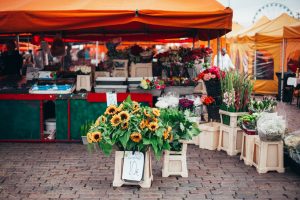
This method is tried and true. If you want to help out workers in your community, buy their local wares.
If you’re lucky enough to have a toymaker in your area, you can expect that they’re being treated fairly. They’re setting their own prices, working hours, and environment.
As any maker can tell you too — the sale of one handmade item is going to bring them exceptional joy. Something you pick up at Wal-Mart is not going to make a huge impact, but it will make a big difference to a local business.
2. Buy Fair Trade

One of the easiest ways to purchase ethically is to buy something that is Fair Trade Certified™.
That’s not to say if it doesn’t have the Fair Trade Certified™ logo that it’s made unethically. It just means you’ll know it has passed a third-party test and you don’t have to do as much research to find out if it’s ethical.
The Fair Trade Certified organization writes,
A choice for Fair Trade Certified™ goods is a choice to support responsible companies, empower farmers, workers, and fishermen, and protect the environment. In other words, it’s a world-changing way of doing business.
From poverty to climate change to struggles with health and safety, people all over the world face incredible challenges simply trying to earn a living. To compete in today’s market, businesses drive down prices at the expense of those most vulnerable: farmers, workers, and fishermen. This simply can’t go on. Shopping fair trade means taking a stand for a system that treats everyone with respect.
To my knowledge, Fair Trade Certified does not work with toys at this time. Perhaps we will see the fair trade logo in the future on all sorts of items.
For now, you can see the fair trade logo popping up on produce, clothing, cooking, coffee, seafood, home goods, and more.
3. Buy Second-hand

Because workers are receiving a fair wage and a safer working place, you can expect fair trade items to be more expensive.
For those who can’t afford the higher price tags, buying second hand is another option.
It’s not necessarily putting money into the hands of underpaid workers, but it’s not supporting unethical practices either. Not only that, but it’s a fight against wastefully purchasing new items and then discarding them in the trash.
Toy waste is a real thing.
According to the Huffington Post, “Plastic toys, which tend to be inexpensive and vibrantly colored, account for 90 percent of the market, according to a plastics trade magazine. And while they pose the same risks as any other plastic item, these cheap playthings often have shorter life spans than high-quality toys and are pretty much impossible to recycle. “
4. Buy From Countries with Fair Working Laws

A lot of Americans like to purchase American made products because they support American workers. It’s also a good idea because companies in America are legally obligated to treat workers fairly and offer a safe working environment.
There are many other countries in the world that also have fair working laws in place. The International Trade Union Confederation (ITUC) says that European countries topped the Global Rights Index in 2018. Among the top countries listed were Norway, Uruguay, and Iceland.
5. Buy Fewer Things

By now, many people are familiar with the Marie Kando method. The Joy of Less. Minimalism.
The idea is to have fewer things in your home so you can have a more organized living space. Your living space should be free from clutter.
Our house could definitely use a good declutter.
But these methods also mean that you shouldn’t immediately purchase something new to fill the gap.
One of the main reasons that we view our belongings as disposable is we buy things at cheap prices, toss it in the garbage when it inevitably wears out, and then we buy something new.
Instead of buying a lot of new toys for your kids, ask if it’s something they’ll actually use. Will this new toy bring them ongoing joy? Will they continue to play with it over time? Is it something that they will treasure?
Can you see passing it on to future generations?
These questions will help limit how many things you bring into your house, AND it’ll give you more buying power to purchase ethically sourced toys and playthings.
6. Buy Quality Items and Take Care of The Items You Have
Buying quality things means that you’re going to have items that last longer. In reference to toys, it means the toys may last to the next generation or could be passed on to another kid once yours has outgrown it. These items usually cost more, but if you’re shopping ethically, it also means that the person who made it is going to be paid a fair wage.
Teaching your children to take care of their belongings is another good way to help fight against reckless consumerism. Naturally, toys are going to break as kids experiment and play. That’s life and it’s nothing to fret over.
But, you can do things to help maintain the life of your toys. Offering a shelf, bin, or tote for their toys is a great first step. When playtime is over, teach them to always return their toys to the same place. That will help keep toys from being stepped on and broken.
Fair Trade Toys You Can Make With and For Your Kids

Okay, so you’ve made it this far.
Now it’s time to get into the making and creating!
If you have a knack for making, or if you want to try your hand at it, here’s a list of toys you can make for your kids.
Toys Made From Disposable Material
Using materials that are otherwise going to be thrown away is a wonderful way to make toys for kids.
I haven’t seen the new Toy Story 4 movie yet, but I have a feeling that the character “Forky” was created along those lines.
Take things like cardboard, egg cartons, old jugs, etc. and you can create new items for kids.
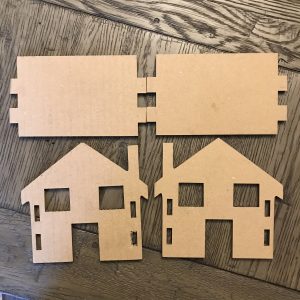
There’s really no limit to what you can do with a good bit of cardboard. From creating forts to making cardboard castles and dollhouses, to recycled crayon LEGO minifigures, to puppet theaters — there are just endless options for creativity.
The best part is your kids can help make their own toys and can design them any way they want.
If you’re not sure where to find cardboard, try your local grocery store or liquor store. Keep your Amazon boxes and ask at local craft stores for their boxes. Many businesses will give you their leftover boxes for free if you call and ask.
Our friend who works locally was able to snag some amazing cardboard that had been placed between shipments.
As I’ve said before, these types of toys don’t have to last forever. However, they’re an avenue for creativity, exploration, and fun. Once your kids lose interest in them, they can be tossed into the recycling bin.
Peg Dolls
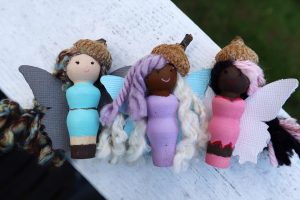
This is one of my favorite toy ideas for kids. You can pick up unpainted peg dolls that are made in the United States. They come in a variety of sizes and shapes to match your kid’s imagination and interests.
You can paint them, add yarn hair, put felt clothes on them — there’s basically no limit to the ideas you can use when it comes to creating peg people.
Your kids can also help you make them which can be a really fun summer boredom-buster activity.
Wooden Blocks

Another idea for handmade toys is to make wooden blocks. You can make them in many different sizes and shapes. You can leave them plain or you can paint them with color safe paints.
Felt Board

A felt board is a timeless plaything for kids. All you need to get started is a board you can cover with felt and additional felt pieces.
Your felt board can be as simple or as intricate as you like. You can make dress-up dolls, fun scenes, letters, numbers, and shapes.
A few years ago I made a felt board for my nieces for Christmas. One niece got a Daniel Tiger-themed felt board and the other one received a board with horses and unicorns.
You can really do any kind of theme for yours. Just pick something your kids are interested in! They’ll love it.
Homemade Playdough

We’ve made homemade playdough dozens of times. You can make it any color you like and you can even add essential oils to scent them.
We’ve used Living Well Mom’s homemade playdough recipe, but there are many other recipes floating around Pinterest and the web. Another one we used recently was The Sweeter Side of Mommyhood’s recipe. The kids really liked this one because they were allowed to color on them with markers.
Puppets
Sock puppets, paper bag puppets, stick puppets, felt finger puppets. Really the ideas are endless for great puppet ideas.
It’s a great two-in-one project because the kids can help make their own puppets and then they can have a blast putting on a puppet show.
If you really want to go above and beyond, you can make a puppet theater out of a cardboard box. I really love this example from one of my favorite Instagram accounts, herding_the_hos.
Tents and TeePees
What kid doesn’t love a good tent?
We make blanket forts here all the time, but you can also make tents that are a bit more permanent. You can make a Hula-Hoop tent, a TeePee tent, or an A-Frame collapsible tent. Another option is a tent made out of a table and a tablecloth.
Matching Games
I haven’t made one of my own, but I think the matching games painted on wooden coins are a-dor-able.
Your kids can also make their own matching games with nothing but paper and markers.
Felt or Crochet Food
If you have some sewing skills or know-how to crochet, you can make some pretend food for your kiddos.
Felt food and crochet food are really popular these days! They’re soft and really cute.
Busy Board and Quiet Books
A busy board is a board that’s covered in activities for kids that they can move and manipulate. Often it deals with their five senses. Examples would be locks, doorbells, gadgets and more.
Quiet books are meant for taking places where you want to keep your kids busy (and quiet). They’re filled with little activities for kids like sorting, decorating, counting, and more.
There are loads of templates available online if you’d like to make one yourself. This mermaid one from Sweet Red Poppy is super cute and you can make it on your Cricut Maker. She even includes the files to download for free!
DIY Chalkboard
With a bucket of chalkboard paint, you can turn just about anything into a DIY chalkboard.
You can put one in your yard, on a big wall in the kitchen, or in a playroom. They’re really fun, but remember that the chalk can also be really messy.
Sandbox
Speaking of messy… kids love sandboxes.

These days there are so many awesome DIY sandbox ideas. But if you’re looking for a simple project, four walls and some bags of sand will do!
DIY Stuffed Animals

Whether you like to sew, knit, or crochet, there are a lot of options for making your kiddos stuffed animals.
I think the amigurumi crochet stuffies are an adorable option.
Dolls
There are some super cute ideas for doll DIYs. I think it’d be a lot of fun making a rag doll or a paper doll.
My favorite rag doll maker is on Etsy. Her Etsy name is 10x2studio. I also love following her on Instagram. In her shop, she sells the actual dolls AND tutorials so you can make your own.
I recently bought some unfinished dolls from her shop and finished them for my daughters for Christmas. I added the hair and dresses but she made the lovely dolls!

Dress-up Clothes

There are soooo many options for making dress-up clothes for your kids. You can pick up dress-up clothes at yard sales, turn old adult clothes into dress-up clothes, or make them from scratch.
You can use cardboard to make a space helmet, turn a cardboard tube into a telescope, and make your own binoculars with a couple of toilet paper rolls.
You can make clothes with a box,
turn some felt into a fox,
use some paper for a tree,
oh it goes on endlessly.
(Sorry. I couldn’t help myself.)
Forts and Mud Pies in the Woods

Almost a year ago, we moved into a new house. We purposefully found a house that had land so our kids could enjoy spending time outdoors.
They really love going into our woods exploring, making forts, and using their imaginations. The other day they were in the creek making things out of the mud.
These moments are priceless (and can’t be bought by MasterCard). So some toys can be made spending no money at all from resources right on your own property.
DIY Board Game

Another really fun project is a DIY board game. My brother has recently been working on a board game and he and his kids all got in on the fun. Hopefully, in the not-so-distant future, he will write a guest post outlining how he made his board game.
Wooden Toys

We already discussed peg dolls and peg doll accessories, but we can’t forget solid wood toys. I found the ones pictured above at the local Salvation Army. Turns out my friend had donated them! (But I didn’t find that out until later). I turned these wooden toys over and they were all made locally in our state. How cool is that!?
Places to Buy Fair Trade Materials for DIY Toys
OK, I know what you might be thinking. How can I MAKE things for my kids ethically when my materials are still sourced unethically.
Great point. I don’t have ALL the answers on this one, but here are some ideas to help point you in the right direction.
Buy Second-hand, Use Old Materials, and Repurpose

I know I’ve really hounded this one a lot of times, but just to reiterate:
If you want to source your materials ethically, repurposing old things is a GREAT option.
If this is something that excites you, check out my blog post 5 Ways to be an Environmentally Friendly Crafter, Maker, and Artist.
Shop at Ethical Places or Shop Ethical Brands
Another way to buy your materials ethically is to shop at places that are ethical or shop brands that are ethical. I’ve collected a list of shopping places to help guide you on your path to being a conscientious maker.
JoAnn Fabrics
It’s not always easy knowing if your crafting materials are ethically sourced. I remember asking this at our local JoAnn Fabrics and didn’t really get satisfying answers to my questions. They do have a disclosure about their supplies which you can read if you’re interested.
However, I do know that JoAnn Fabrics has a selection of fabric made in the U.S.A. They also carry yarn brands that are made in America.
Some yarn brands that are made in America are Red Heart Yarn, certain types of Lion Brand Yarn, and Lily’s Sugar‘n Cream.

I use Lily Sugar’n Cream to make my dishcloths.
Darn Good Yarn

There are actually quite a few ethically sourced yarn companies, but Darn Good Yarn is a great place to start.
On their website they write, “Our yarns utilize textile waste, are fair-trade and sustainably sourced, and offer a living wage to women entrepreneurs in India and Nepal.” They even offer a selection of vegan yarn if that’s up your alley.
NaturalRecycledYarn

NaturalRecyleYarn is a yarn business created by Misti Nolan. She is located in the United States and sources her yarn from 100% natural fibers recycled from sweaters.
According to her Instagram, she’s recycled 769,066 yards and counting.
She started recycling yarn for the reasons many makers start doing things. She wanted a lot of high-quality yarn so she could produce her art. Once she got started, she realized she had more than she needed for her personal needs and began her business.
I spoke with her and she said that her yarn is 100% sustainable. It comes in a variety of sizes, colors, and materials. You can get various types of wool, cotton, linen, and more.
Clickity Clack Collectibles

Clickity Clack Collectibles is an awesome resource for your peg doll needs. They have such an imaginative collection of cutouts, dolls, scenes, animals. They’re really quite versatile when it comes to creating things for the peg doll/wooden cutout world.
I don’t know about you, but just seeing all those blank wooden creations makes me itch to get my paintbrush out and start adding some color.
It’s a family-owned business and they source all of their materials from the United States and Canada. I spoke with the owner Phyllis and she wrote to me,
We make what we sell except for a few peg dolls and turnings that are about 95% made in the US. The lumber we use for our toys is pine from the US and sometimes Canada. I design our blanks and toys and Ron cuts them. There are just the 2 of us, so we do it all.
Milkpaint
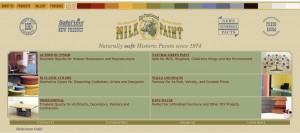
If you want to create something with paint you may want to consider Milk paint. These paints are made in the USA and created from natural products (so environmentally friendly too!)
Originally created for furniture makeovers, you can also purchase sample sizes for $4.00 that would be perfect for craft projects.
Apple Barrel Paints by Plaid
I am not very familiar with the sourcing practices of Plaid, but I did find that their Apple Barrel paints are non-toxic and made in the United States.
They’re very inexpensive and come in a variety of colors.
EcoEpoxy as a Mod Podge Alternative

If you love Mod Podge but want an eco-friendly alternative, you may be interested in EcoEpoxy.
It is more expensive than Mod Podge, but it is made in the USA and it is safer for you and the environment. It’s created by Earth Base Finishes which specializes in VOC and heavy-metal free paints and finishes.
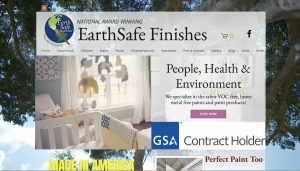
Pacon Tru-Ray Construction Paper
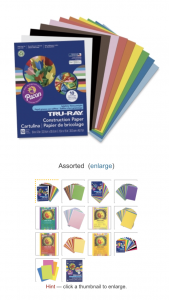
If you’re after construction paper, consider Pacon Tru-Ray Construction paper. It comes in a variety of colors and it is a heavy weight paper. It’s also 50% recycled material and made in the US!
I wasn’t sure where it was made so I jumped on live chat and doublechecked that it was made in the US.
A Child’s Dream

A Child’s Dream supplies natural materials for many different craft projects. They have 100% wool felt available, doll making materials, dyeing, fibers, and more.
I spoke with them on Facebook messenger and they told me that the majority of their supplies come from the European Union and the United States.
Places to Buy Ethical Fair Trade Toys

For those who would rather not make their toys but still want fair trade options, here are some amazing shops and businesses that are either fair trade businesses or are small shops that make their items themselves.
These individual makers set their own prices and hours — and while they may work long hours creating beautiful toys — their working spaces, hours, and wages are all within their control.
Scribble Subscription Box

I came across Scribble Subscription Box one day and LOVED what I saw. A place that believed in letting kids use their imaginations to make their own toys and then play with them. They’re all about creativity and simple things — like cardboard boxes. The boxes they come in are part of the creation! That’s brilliant.
Each subscription box comes with everything you need to make something for their cardboard house. As they explain on their site, “The house grows and grows with each shipment.”
I wrote to them directly to find out about their sourcing practices. Here’s the response I received:
Hi! Thank you for reaching out! Yes!! We use a small local manufacturer and environment-friendly sustainable materials. We also strive to use reasonable, responsible packaging. We just finished designing these single art kits. They are based on popup books, and encourage kids to reuse, recycle, and repurpose! Reducing unnecessary waste and promoting battery-free creative play is our mission!
MyPrettyPeggy

If you’re looking for peg dolls for your kids, I have a great place for you to shop! MyPrettyPeggy not only creates incredibly beautiful and detailed peg dolls, but the creator also genuinely has a heart for people.
Though I have not met her in person, it’s clear through her Instagram feed and stories that she cares about others. For fair trade purposes, I asked her about her sourcing methods and she said all of her peg dolls are produced ethically. She uses non-toxic paint made in the US and her dolls are also purchased from family-owned woodshops in the United States.
I think my two favorite types of peg dolls that she creates are her literary ones, and the ones she makes based on vintage Pyrex dishes.
Her peg doll designs are gorgeous and one-of-a-kind. Oh, and she also sells wooden hair accessories as well!
Zooble

If you’re looking for magical, original, and just downright beautiful toys for your kids, I highly recommend Zooble.
Her designs are just incredible and fun, and I’m not even kidding… I want to play with the toys she creates. In her shop, she carries fairies, playsets, bendable dolls, peg dolls, and so much more.
As a yarn-lover, I can’t help but fawn over her peg doll’s hair. I’ve never seen anything quite like it.
About the shop, they say, “Zooble’s toys are handmade by our small team here in magical Vermont…Each and every toy is handcrafted with hours of detailed craftmanship and love…Our toys will be loved by your little ones for years and last for years as well. They will be something to pass down to the next generation as treasures from childhood.”
Ohlittlewren

Ohlittlewren is an adorable shop that has a mix of handcrafted children’s toys, decorations, wall hangings, DIY kits, earrings, and more. Her designs are unique, classy, and oh-so-pretty.
I especially love the wooden rainbow puzzle!

cuddle+kind

Cuddle+kind was a business created to help children-in-need meet their nutritional needs. On their site, they explain, “We created cuddle+kind because we wanted to make beautiful hand-knit dolls that help feed children. So for every cuddle+kind doll sold, we give 10 meals to children in need.”
To date, they’ve provided over 9 million meals.
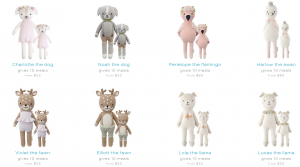
The purchase of these dolls not only provides meals to children, but they also provide jobs. The dolls are made in Peru by women artisans and they’re created using fair trade practices. The creators of cuddle+kind write,
…all our hand-knit dolls are ethically produced in Peru where we provide over 750 talented artisans with a sustainable, fair trade income.
For us, fair trade is a commitment to a different way of doing business. It’s about putting the principles of fairness and decency before profits. This means that we are committed to paying women artisans fairly and equitably for their work which allows them to care for their families and plan for their futures. We are proud when we hear about the meaningful change this brings to their lives.”
These dolls are also available on Amazon.
Green Mountain

Green Mountain is an adorable Etsy store that sells a variety of toys. Located in Vermont, maker Valerie Mazzarella has created peg doll sets, wool crowns, gnome cottages, and so many other treasures! Each product is made from natural materials like wool, wood, cotton, and silk.
On her Etsy page, she writes, “We offer special and unique handmade, knitted and felted treasures, in the Waldorf tradition, each made with great love and care, using only the highest quality natural fibers and materials.
Toys crafted of materials like wood, wool, silk and cotton connects our children with the natural world and encourages creative and imaginative play.”
Tansy Dolls
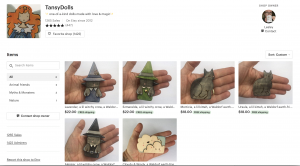
Another shop that’s so cute you can hardly stand it is Tansy Dolls. Each doll is one-of-a kind and handmade.
They included their story on their Etsy page and this is what it says,
We’re friends. We’re mamas. We’re artists and craftsters. We’re Lesley, Cady, and Robin
…we became VERY excited about combining our talents to work together to produce handcrafted lovelies for children to snuggle with and adore. We noticed a huge lack of diversity in children’s toys and aimed to change that.
And that SPARK of excitement, of creativity, of holding onto the joy of building beauty with our hands & minds is what brings us (and you!) here today.
Oompa Fair Trade Toys

Oompa Toys are another line of toys that are worth checking out.
It’s important to note that Oompa has some toys that are not fair trade. However, they have a line of toys that are fair trade and they’re organic and sustainably sourced as well.
At Oompa toys, they believe that kids should use their imaginations daily. They write,
It’s this commitment to imaginative play that inspires everything we do here at Oompa. We believe that fostering children’s relationships to nature and to the world around them is important. Our mission is to keep this planet of theirs protected so that generations of future puddle jumpers can continue to look at it with wonder.

Their toys are ethically made and free from harmful substances — they’re also organic and are never made from plastic!
Thirty-One Bits
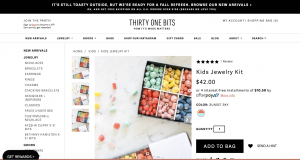
Thirty-one Bits is a fair-trade company that started as a way to help women in Uganda find a market for their beads and jewelry.
There aren’t a lot of toys on this site, but I did think their kid’s jewelry kit was really cute. These beads are made from paper and they are hand-rolled in Uganda.
Mercy House Global

Mercy House Global is a Christian organization that seeks to treat women fairly and help them create businesses in a sustainable way.
Their mission statement explains, “Mercy House exists to engage, empower and disciple women around the globe in Jesus’ name. Engage those with resources to say yes to the plight of women in poverty. Empower women and teenage mothers around the world through partnerships and sustainable fair trade product development. Disciple women to be lifelong followers of Jesus Christ.”
Amador Training Soccer Ball
I reached out to Fair Trade Certified directly and asked them if they could point me in the direction of fair trade toys. Here was their response:
Hello Hannah,
Thanks for reaching out! At this time Fair Trade Certified does not certify toys. We do, however, certify soccer balls. This one from Senda Athletics would be a good fit for children’s sports:

I felt that this was a pretty affordable price for something useful that is also fair trade. I loved that they had this option! Hopefully, there will be more fair trade certified toy options in the future.
Bella Luna Toys

Bella Luna Toys is yet another great option for fair trade toys. I got this suggestion from fellow blogger Erna Carter from Enjoy the Eco Things.
These toys are largely Waldorf style toys and they also have arts and crafts, home decor, books, and music. I reached out to them and asked if their toys were fair trade and they responded that they do carry many fair trade toys. It may take a little searching or asking to determine which toys are fair trade, but it does seem that this company is ethically minded in general.

Bella Luna Toys is committed to offering unique natural toys and products for children and families that are safe, healthy, and encourage imaginative play. You will find no battery-operated or plastic toys here, the kind that will be played with for a short time before ending up in a landfill.
Our quality toys are not disposable. They are built to last; the kind of toys that can be passed on or handed down to future generations.
Most of our toys are made in the USA, Europe, or Canada. The ones made overseas are certified to be ethically and sustainably made. Our toys have been tested to meet the strictest safety standards.
The emphasis is mine, but it’s clear that they strive to be an ethical company.
LEGO
I want to take a moment to talk about LEGO.

Of course, LEGO requires no introduction as millions of people (kids and adults) enjoy building and engineering with these tiny marvels.
Our family loves LEGOs. Our kids play with them almost daily and we have a large collection of them (probably too many!).
While I can’t call them fair trade or entirely eco-friendly (they are made of plastic and they come with plastic packaging), this company does have a few very good things going for them.
- They’re moving towards more sustainable materials. They’re starting to create bricks from plant-based polyethylene. Their current goal is to make all of their LEGO toys sustainable by 2030.
They also care about other parts of their environmental impact. They explain “The LEGO Group aims to send zero waste to landfill by 2025, and in 2018 recycled 93% of all waste from our operations. Additionally, 100% of all plastic waste produced during the moulding of LEGO® bricks was recycled. This includes reusing some of the plastic resin in our own processes, as well as sending some of the waste to suppliers to be recycled and turned into other plastic products.”

They’re also balanced 100% by renewable energy. They state, “in 2018, the energy output from our investments in renewables was greater than the energy used at LEGO.”® factories, offices and stores.
2. They really do seem to have a higher standard for their factories and employee care than some. They claim to aim for “zero accident” factories, and they comply with “national and international legislation, as a minimum requirement.”
They also claim that that they never employ children and that all forms of slavery
and forced labor are prohibited. They write, “Forced labour is defined as any situation where workers are forced to work against their will or under pressure from a threat of punishment.”
LEGO is also a member of the ICTI Ethical Toy Program. To read more about their sourcing and employee practices, check out their responsible business principles page.

Again, I wouldn’t claim that LEGO is fair trade and I recognize the problems with plastics. But, I do think they’re more ethically conscious than many competing businesses in the world.
Another thing in LEGO’s favor is their toys can be used for more than one generation, and they have a healthy second-hand market.
So you know that your purchase of LEGO can probably be passed down (my kids play with LEGO that my brothers and I had when we were kids). You can also buy used LEGO if you’d prefer not to contribute to the addition of new plastics into the world.
The Fair Trade Ethical Toy Takeaway

My hope is never to make people feel guilty or ashamed. Our house has plenty of things that aren’t fair trade and aren’t eco-friendly. Instead, I hope to make it easier for you to make small changes in the way you purchase. I hope to take away some of the burden of searching for ethical places — and give you a really handy guide for making and buying fair trade toys.
Consumers can’t change everything, but we can push things in the right direction. I’ve already seen a change in the way people view plastics and the treatment of workers. In America, we want fair labor laws and practices. We want safe work environments and reasonable wages. That’s what it’s all about really — treating other people the way we want to be treated.
If we can do that through something as simple as making or purchasing a toy — that’s an easy change.










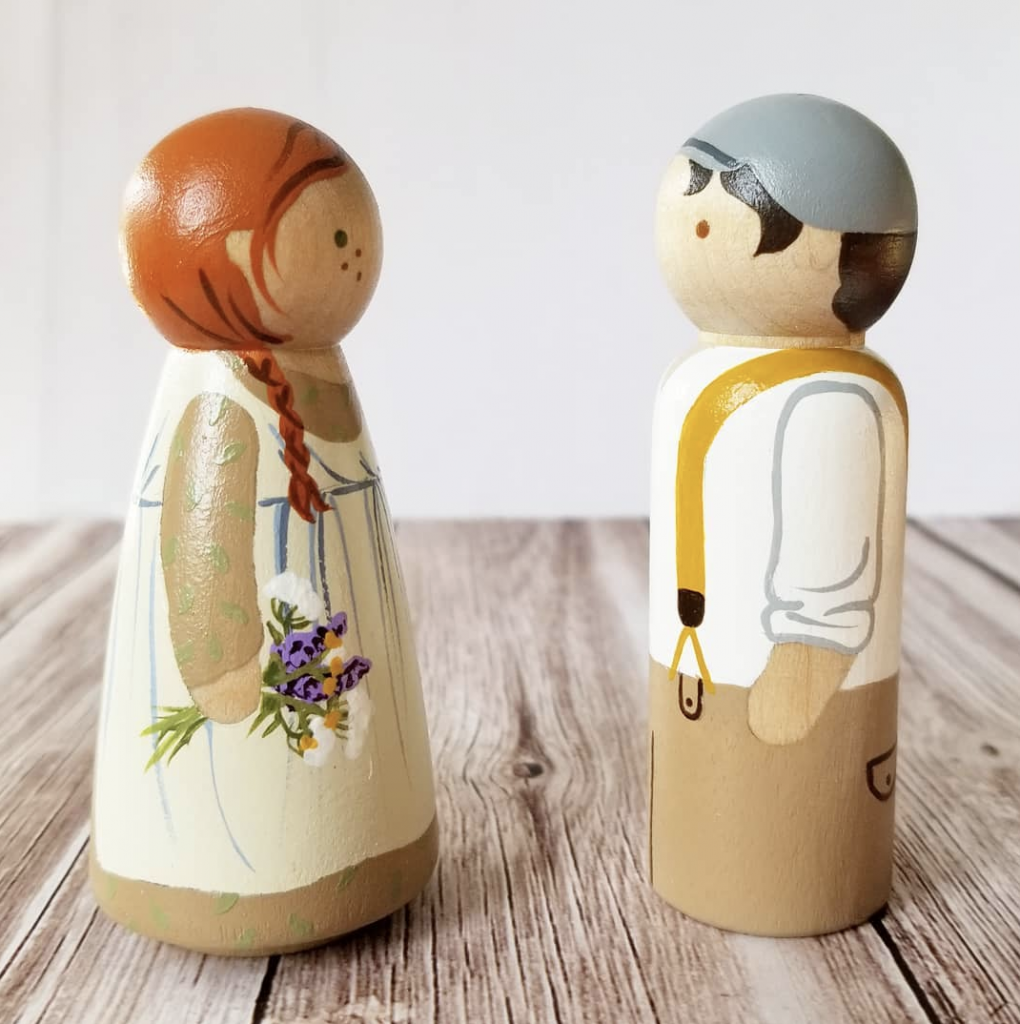

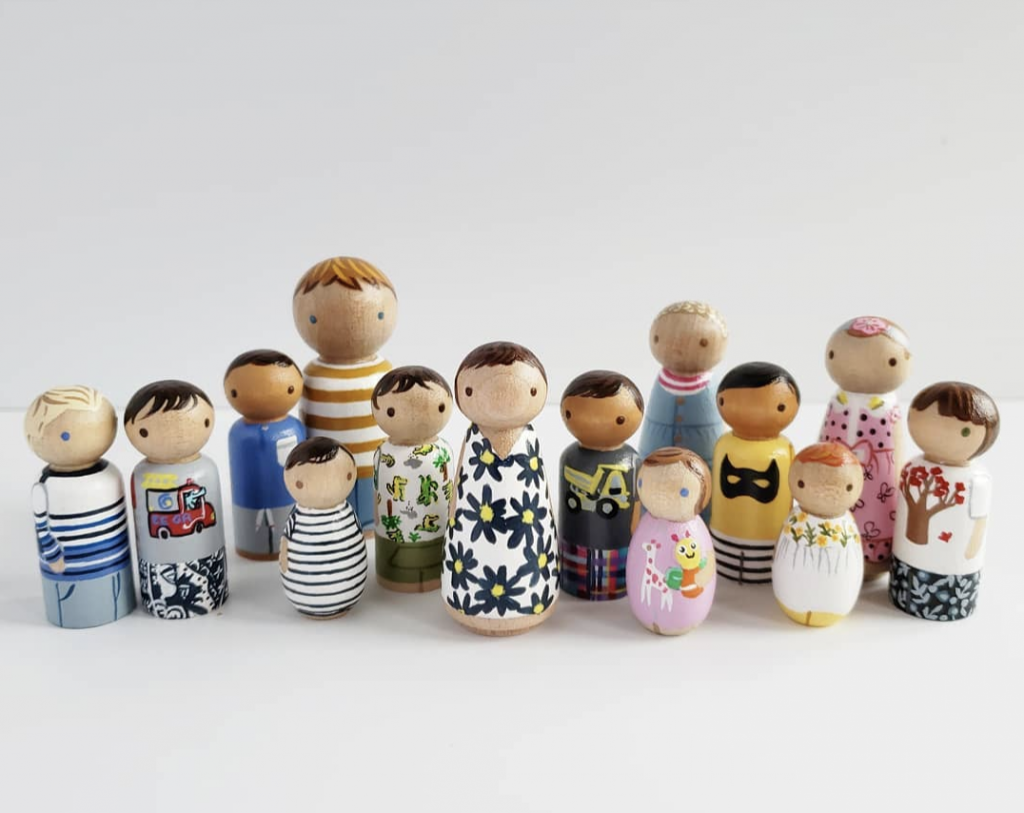













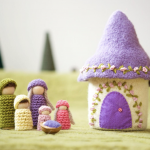










8 Comments
Alexis
I loved this article! It’s amazing that you shed some light on fair trade toys. I think it’s important to slow down with our kiddos and allow them to play with their imagination! I definitely learned so much.. thank you!!
Ned
Thank you so much for the thoughtful response. I’m totally with you — I like the idea of toys without screens that inspire imagination. I believe that as time goes on, there will be more toys that check the boxes for ethical and sustainable.
-Hannah
Nina | Lemons and Luggage
Thanks so much for this! I always struggle with what gifts to buy for my nephew because I try to live a more ethical and sustainable life. It often seems like toys are the one thing that are overlooked in the debate on fair trade, but you have such a great list of ethical options here!
Ned
Thank you for the kind response! I felt similarly when I was thinking about Christmas coming up. I love getting gifts for my kids and I wanted to know what gift options were available that were ethical. There wasn’t a whole lot of information on my Google search… but I feel like there are probably other people like me who want to know too! -Hannah
ปั้มไลค์
Like!! Great article post.Really thank you! Really Cool.
Pingback:
Pingback:
Pingback: